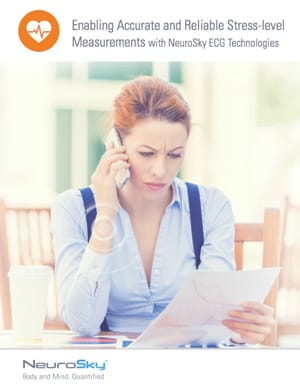If you’ve ever worn a biosensor monitor, you know how insightful the readings can be. Wearables provide helpful prompts about when stress levels are high, or when to take a walk. In the future, these devices will be used to monitor heart rate variability (HRV) for people with long term health issues, immediately providing essential information to medical teams. But what is heart rate variability, and why is responding to it so important?
What is Heart Rate Variability?
HRV measures the time between heartbeats. More specifically, it measures the beat-to-beat interval, indicating how regular or irregular a heartbeat is. In contrast to your heart rate—the number of heartbeats per minute—HRV measures the length of time between one heart beat and the next.
Ideally, the HRV won’t be consistent. This sounds counterintuitive; with heart rate, the goal is to achieve a consistent range (for adults, the goal is between 60 to 100 beats per minute). However, as heart rate variability measures the length of time between heartbeats, it acts as a measure of how your body reacts to outside stressors. An inconsistent heart rate variability means your body can more easily respond to different situations like increased anxiety, while a lower HRV indicates a lower level of resilience to environmental stimuli.
Feeling Zen: Monitoring HRV Through Non-Invasive Wearables
We could all prob ably benefit from a helpful assistant who reminds us to take a few deep breaths, or encourages us to meditate. Increasingly, wearables and their corresponding apps are being used to do just that. They track stress or anxiety, and give prompts to start breathing exercises, avoid doing strenuous activity at the gym, or whether to get some more sleep. By monitoring HRV on an ongoing basis, you’ll be able to make proactive changes to improve your overall stress levels and your body’s resilience.
ably benefit from a helpful assistant who reminds us to take a few deep breaths, or encourages us to meditate. Increasingly, wearables and their corresponding apps are being used to do just that. They track stress or anxiety, and give prompts to start breathing exercises, avoid doing strenuous activity at the gym, or whether to get some more sleep. By monitoring HRV on an ongoing basis, you’ll be able to make proactive changes to improve your overall stress levels and your body’s resilience.
Call the Doctor: Medical Applications for Heart Rate Variability Monitors
Heart rate variability can indicate how well a person responds to stress, but it can also indicate whether a patient is suffering from serious heart diseases or other illnesses. Being able to track HRV lets medical teams assess a patient’s health, and determine whether intervention is required. Along with multiple cardiac issues, lower HRV can indicate that a patient is suffering from:
- Diabetic neuropathy
- Liver cirrhosis
- Sepsis
The Business Case for Heart Rate Variability Monitoring
Observing heart rate variations has wider uses than just day to day health and wellness tracking or medical monitoring. In fact, the European Institute of Innovation and Technology is using HRV monitors in a study to measure the health of truck drivers. Most trucking firms already collect data about vehicles and routes such as location and fuel consumption within their fleet management systems. In most cases, no data is collected about the health of the drivers themselves.
The drivers included in the study will wear a device to measure HRV and skin temperature among other metrics. This information will be used to determine whether the driver is getting adequate sleep, and how alert or stressed they are. With this data, fleet managers can determine whether drivers are more suited to certain routes than others, whether they are fit to be on the road. Fleet managers will be alerted when a driver might not be road-ready, and drivers will get a wider picture of their overall health, enabling both to respond to potential health issues before they become more significant.
HRV Monitoring: Wearables for Health and Wellbeing
The best way to monitor HRV is through non-invasive ECG biosensor-enabled wearables, like those powered by NeuroSky’s ECG CardioChip™. Easily incorporated into a range of wearable devices, ECG chips and their algorithms make monitoring convenient for the user—and data collection straightforward for medical staff—enabling accurate readings when and where they are needed most.



